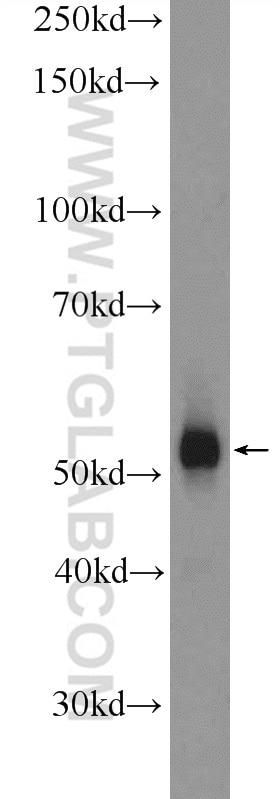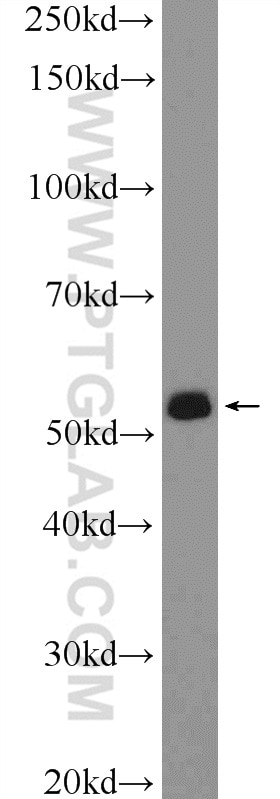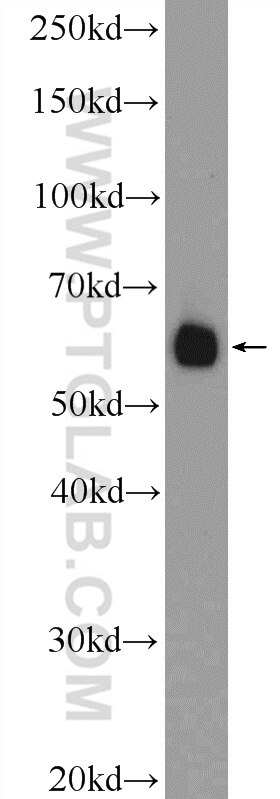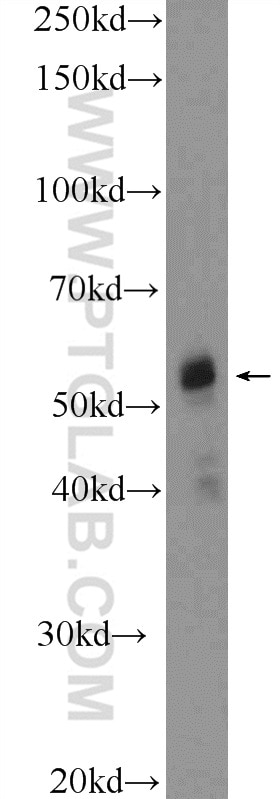DAZ4 Polyklonaler Antikörper
DAZ4 Polyklonal Antikörper für WB,ELISA
Wirt / Isotyp
Kaninchen / IgG
Getestete Reaktivität
human, Maus, Ratte
Anwendung
WB,ELISA
Konjugation
Unkonjugiert
Kat-Nr. : 14065-1-AP
Synonyme
Galerie der Validierungsdaten
Geprüfte Anwendungen
| Erfolgreiche Detektion in WB | Maushodengewebe, humanes Hodengewebe, Rattenhodengewebe |
Empfohlene Verdünnung
| Anwendung | Verdünnung |
|---|---|
| Western Blot (WB) | WB : 1:500-1:1000 |
| It is recommended that this reagent should be titrated in each testing system to obtain optimal results. | |
| Sample-dependent, check data in validation data gallery | |
Produktinformation
14065-1-AP bindet in WB,ELISA DAZ4 und zeigt Reaktivität mit human, Maus, Ratten
| Getestete Reaktivität | human, Maus, Ratte |
| Wirt / Isotyp | Kaninchen / IgG |
| Klonalität | Polyklonal |
| Typ | Antikörper |
| Immunogen | DAZ4 fusion protein Ag5116 |
| Vollständiger Name | deleted in azoospermia 4 |
| Berechnetes Molekulargewicht | 65 kDa |
| Beobachtetes Molekulargewicht | 60-65 kDa |
| GenBank-Zugangsnummer | BC047617 |
| Gene symbol | DAZ4 |
| Gene ID (NCBI) | 57135 |
| Konjugation | Unkonjugiert |
| Form | Liquid |
| Reinigungsmethode | Antigen-Affinitätsreinigung |
| Lagerungspuffer | PBS mit 0.02% Natriumazid und 50% Glycerin pH 7.3. |
| Lagerungsbedingungen | Bei -20°C lagern. Nach dem Versand ein Jahr lang stabil Aliquotieren ist bei -20oC Lagerung nicht notwendig. 20ul Größen enthalten 0,1% BSA. |
Hintergrundinformationen
DAZ4, encoded by the DAZ gene, is an RNA-binding protein with a role in spermatogenesis. DAZ4 is a testis-specific protein that expression restricted to premeiotic germ cells, particularly in spermatogonia. Defects in DAZ4 may be a cause of spermatogenic failure Y-linked type 2 (SPGFY2). It is a disorder resulting in the absence (azoospermia) or reduction (oligozoospermia) of sperm in the semen, leading to male infertility.
Protokolle
| Produktspezifische Protokolle | |
|---|---|
| WB protocol for DAZ4 antibody 14065-1-AP | Protokoll herunterladen |
| Standard-Protokolle | |
|---|---|
| Klicken Sie hier, um unsere Standardprotokolle anzuzeigen |





